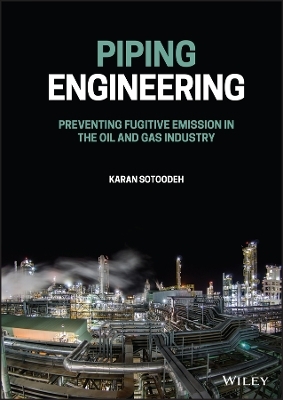
Piping Engineering
John Wiley & Sons Inc (Verlag)
978-1-119-85203-2 (ISBN)
Piping Engineering: Preventing Fugitive Emission in the Oil and Gas Industry is a practical and comprehensive examination of strategies for the reduction or avoidance of fugitive emissions in the oil and gas industry. The book covers key considerations and calculations for piping and fitting design and selection, maintenance, and troubleshooting to eliminate or reduce emissions, as well as the various components that can allow for or cause them, including piping flange joints.
The author explores leak detection and repair (LDAR), a key technique for managing fugitive emissions. He also discusses piping stresses, like principal, displacement, sustained, occasional, and reaction loads, and how to calculate these loads and acceptable limits. Various devices to tighten the bolts for flanges are described, as are essential flange fabrications and installation tolerances.
The book also includes:
Various methods and calculations for corrosion rate calculation, flange leakage analysis, and different piping load measurements
Industry case studies that include calculations, codes, and references
Focuses on critical areas related to piping engineering to prevent emission, including material and corrosion, stress analysis, flange joints, and weld joints
Coverage of piping material selection for offshore oil and gas and onshore refineries and petrochemical plants
Ideal for professionals in the oil and gas industry and mechanical and piping engineers, Piping Engineering: Preventing Fugitive Emission in the Oil and Gas Industry is also a must-read resource for environmental engineers in the public and private sectors.
Karan Sotoodeh, PhD, has worked as a Valve and Actuator Senior/Lead Engineer for Baker Hughes in Oslo, Norway. He received his doctorate from the University of Stavanger and has published approximately 30 peer-reviewed papers and a book about piping and valves.
Author Biography ix
1 An Introduction to Fugitive Emission, Piping Engineering, and LDAR 1
1.1 Introduction to Fugitive Emission 1
1.2 Introduction to Piping Engineering 5
1.3 Causes of Piping Failure and Leakage 8
1.4 Leak Detection and Repair (LDAR) 13
1.4.1 Composite Repair 14
1.4.2 Mechanical Clamp Repair 14
1.4.3 Welded Leak Box Repair 15
1.4.4 External Weld Overlay 16
1.4.5 Sleeve Repair 17
1.5 Questions and Answers 18
Further Readings 21
2 Piping Pressure Design to Prevent Leakage and Emission 23
2.1 Introduction to Piping Design 23
2.2 Piping and Pipeline Wall Thickness Calculation 23
2.2.1 Piping Wall Thickness Calculation as per ASME B31.3 23
2.2.2 Pipeline Wall Thickness Calculation 32
2.3 Pipe Fittings Wall Thickness/Pressure Rating 51
2.4 Flange Pressure Rating and Thickness Selection 59
2.5 Questions and Answers 70
Further Readings 84
3 Piping Stress Analysis to Prevent Operational Failure 87
3.1 Introduction to Piping Stress Analysis 87
3.2 Principal Piping Stresses 87
3.3 Sustained Loads 96
3.4 Occasional Loads 106
3.4.1 Earthquake and Blast Load 106
3.4.2 Wind Load 109
3.5 Displacement Stress 111
3.5.1 Stress Intensification Factor (SIF) 127
3.6 Piping Reaction Forces 133
3.6.1 Pressure Safety/Relief Valve Reaction Force 133
3.6.2 Slug Flow Reaction Force 138
3.6.3 Water Hammering Load Calculation 143
3.7 Conclusion 145
3.8 Questions and Answers 146
Further Readings 153
4 Piping Flange Joints 155
4.1 Introduction 155
4.2 Flanges 157
4.2.1 Flange Standards 157
4.2.2 Flange Types 162
4.2.3 Flange Faces 175
4.2.4 Flange Surface (Face) Finish 184
4.2.5 Flange Identification 185
4.2.6 Flange Installation 185
4.3 Gaskets 190
4.3.1 Nonmetallic Flat Gaskets 191
4.3.2 Semimetallic Gaskets 192
4.3.3 Metallic Gaskets 196
4.4 Bolting (Bolts and Nuts) 197
4.4.1 Bolt Tightening 204
4.5 Mechanical Joints (Hubs and Clamps) 210
4.6 Compact Flanges 212
4.7 Questions and Answers 216
Appendix A 220
Further Readings 223
5 Piping Flange Joint Calculations 227
5.1 Introduction 227
5.2 Bolt Length Determination and Calculation 228
5.2.1 Long Bolt Length Calculation for Wafer Body Valves 236
5.2.2 Long Bolt Length Calculation for Flanges with Line Blanks 239
5.3 Flange Leakage Analysis 245
5.3.1 Bolting Characteristics 247
5.3.2 Gasket Behavior 253
5.3.3 Combination of Bolt Loads and Gasket Reaction 254
5.3.4 Flange Loading 262
5.3.5 Pressure Equivalent Method 269
5.4 Questions and Answers 270
Appendix A 275
Further Readings 277
6 Piping Material Selection and Corrosion Prevention 279
6.1 Introduction 279
6.2 Onshore Pipeline 281
6.2.1 Onshore Pipeline Material Selection 281
6.2.2 External Corrosion 282
6.2.3 Pipeline External Corrosion Protection 284
6.2.4 Pipeline Internal Corrosion Types and Mitigation 287
6.3 Onshore Piping 301
6.3.1 Onshore Piping Material Selection 301
6.3.2 Onshore Piping Corrosion Types 315
6.4 Offshore Piping 317
6.4.1 Offshore Piping Material Selection 317
6.4.2 Offshore Piping Corrosion Study 320
6.5 Questions and Answers 322
Further Readings 327
7 Piping Component Selection and Identification 329
7.1 Introduction and Overview 329
7.2 Pipe 329
7.3 Pipe Fittings 331
7.3.1 Fittings for Piping Route Change 331
7.3.2 Fittings for Pipe Size Change 336
7.3.3 Fittings for Branching 341
7.3.4 Fittings for Pipe Termination or Blinding 352
7.4 Questions and Answers 356
Further Readings 361
8 Piping Fabrication, Inspection, and Testing 363
8.1 Introduction and Overview 363
8.2 Fabrication, Assembly, and Erection 363
8.2.1 Welding 367
8.3 Inspection 378
8.3.1 Introduction 378
8.3.2 Welding Inspection 379
8.4 Piping Pressure Test 385
8.4.1 Test Media 386
8.4.2 Test Preparation 387
8.4.3 Test Implementation 387
8.5 Questions and Answers 389
Further Readings 393
Index 395
| Erscheinungsdatum | 28.10.2022 |
|---|---|
| Verlagsort | New York |
| Sprache | englisch |
| Maße | 183 x 257 mm |
| Gewicht | 998 g |
| Themenwelt | Naturwissenschaften ► Chemie ► Technische Chemie |
| Technik ► Elektrotechnik / Energietechnik | |
| Technik ► Maschinenbau | |
| ISBN-10 | 1-119-85203-X / 111985203X |
| ISBN-13 | 978-1-119-85203-2 / 9781119852032 |
| Zustand | Neuware |
| Informationen gemäß Produktsicherheitsverordnung (GPSR) | |
| Haben Sie eine Frage zum Produkt? |
aus dem Bereich


